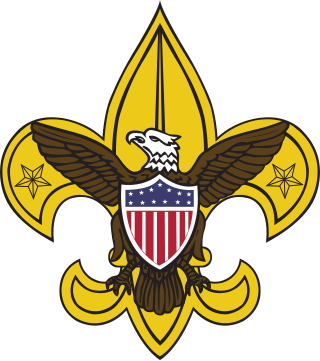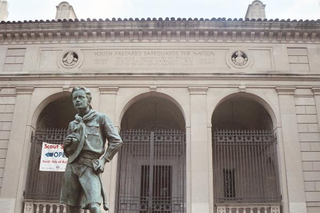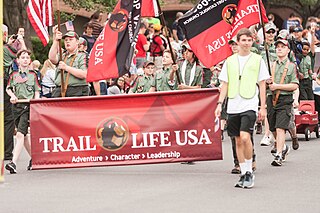
Scouting, also known as the Scout Movement, is a worldwide youth social movement employing the Scout method, a program of informal education with an emphasis on practical outdoor activities, including camping, woodcraft, aquatics, hiking, backpacking, and sports. Another widely recognized movement characteristic is the Scout uniform, by intent hiding all differences of social standing in a country and encouraging equality, with neckerchief and campaign hat or comparable headwear. Distinctive uniform insignia include the fleur-de-lis and the trefoil, as well as merit badges and other patches.

Unitarian Universalist Association (UUA) is a liberal religious association of Unitarian Universalist congregations. It was formed in 1961 by the consolidation of the American Unitarian Association and the Universalist Church of America Christian denominations with Unitarian and Universalist doctrines, respectively. However, modern Unitarian Universalists see themselves as a separate religion with its own beliefs and affinities. They define themselves as non-creedal, and draw wisdom from various religions and philosophies, including humanism, pantheism, Christianity, Hinduism, Buddhism, Taoism, Judaism, Islam, and Earth-centered spirituality. Thus, the UUA is a syncretistic religious group with liberal leanings.

Unitarian Universalism is a liberal religious movement characterized by a "free and responsible search for truth and meaning". Unitarian Universalists assert no creed, but instead are unified by their shared search for spiritual growth. Unitarian Universalists do not have an official, unified corpus of sacred texts but rather draw inspiration and guidance from the six sources: personal experience, prophetic utterances, world religions, Jewish and Christian teachings, humanist teachings, and spiritual teachings. Unitarian Universalist congregations include many atheists, agnostics, deists, and theists; there are churches, fellowships, congregations, and societies around the world.

The Boy Scouts of America is one of the largest scouting organizations and one of the largest youth organizations in the United States, with about 762,000 youth participants. The BSA was founded in 1910; about 110 million Americans have participated in its programs. BSA became a founding member organization of the World Organization of the Scout Movement in 1922.

Advancement and recognition in the Boy Scouts of America is a tradition dating from the inception of the Scouting movement. A fundamental purpose of advancement is the self-confidence a young man or woman acquires from his participation in Scouting. Advancement is one of the methods used in the "Aims and Methods of Scouting"– character development, citizenship training and personal fitness.

Girl Scouts of the United States of America (GSUSA), commonly referred to as simply Girl Scouts, is a youth organization for girls in the United States and American girls living abroad. Founded by Juliette Gordon Low in 1912, it was organized after Low met Robert Baden-Powell, the founder of Scouting, in 1911.

Cub Scouting is part of the Scouting program of the Boy Scouts of America (BSA), available to boys and girls from kindergarten through fifth grade, or 5 to 10 years of age and their families. Its membership is the largest of the five main BSA divisions. Cub Scouting is part of the worldwide Scouting movement and aims to promote character development, citizenship training, personal fitness, and leadership.

A variety of religious emblems programs are used by the Boy Scouts of America (BSA) to encourage youth to learn about their faith and to recognize adults who provide significant service to youth in a religious environment. These religious programs are created, administered and awarded by the various religious groups, not the BSA, but each program must be recognized by the BSA.

Sea Scouts is a program of the Boy Scouts of America for young men and women ages 14 through 20.
The Boy Scouts of America (BSA), one of the largest private youth organizations in the United States, has policies which prohibit those who are not willing to subscribe to the BSA's Declaration of Religious Principle, which has been interpreted by some as banning atheists, and, until January 2014, prohibited all "known or avowed homosexuals", from membership in its Scouting program. The ban on adults who are "open or avowed homosexuals" from leadership positions was lifted in July 2015.

The American Heritage Girls (AHG) is a Christian-based Scouting-like organization for Americans. The organization has more than 52,000 members (2020) with troops or individuals ("trailblazers") in all 50 states of the United States and for American expatriates in fifteen other countries.

Scouts BSA is the flagship program and membership level of the Boy Scouts of America (BSA) for boys and girls between the ages of typically 11 and 17. It provides youth training in character, citizenship, and mental and personal fitness. Scouts are expected to develop personal religious values, learn the principles of American heritage and government, and acquire skills to become successful adults.

Scouting in the United States is dominated by the 1.2 million-member Boy Scouts of America and the Girl Scouts of the USA and other associations that are recognized by one of the international Scouting organizations. There are also a few smaller, independent groups that are considered to be "Scout-like" or otherwise Scouting related.

The Boy Scouts of America (BSA) was inspired by and modeled on The Boy Scouts Association, established by Robert Baden-Powell in Britain in 1908. In the early 1900s, several youth organizations were active, and many became part of the BSA.

Religion in Scouting and Guiding is an aspect of the Scout method that has been practiced differently and given different interpretations in different parts of the world over the years.

Square knot insignia are embroidered cloth patches that represent awards of the Scout associations throughout the world.
A variety of religious emblems programs are used by the Girl Scouts of the USA (GSUSA) to encourage youth to learn about their faith and to recognize adults who provide significant service to youth in a religious environment. These religious programs are created, administered and awarded by the various religious groups and not GSUSA, though the GSUSA recognizes such programs and allows the emblem to be worn on the uniform. Many are listed by Programs of Religious Activities with Youth (P.R.A.Y.), an independent organization, as awards recognized by the Girl Scouts in an official brochure provided to Girl Scout council offices, as well as posted on the P.R.A.Y. website. The Girl Scouts also recognize that not all religions have programs that are affiliated through P.R.A.Y. and suggests contacting local religious leaders for information about those.
Youth organizations in the United States are of many different types. The largest is the government run 4-H program, followed by the federally chartered but private Scouting movement groups: the Boy Scouts of America (BSA) and the Girl Scouts of the USA (GSUSA). Another somewhat smaller but co-ed Scouting derived group is Camp Fire. Other youth groups are religious youth ministries such as the evangelical Christian Awana, Seventh-day Adventist Pathfinders, and Assemblies of God Royal Rangers.

Trail Life USA is a faith-based non-aligned Scouting organization providing youth mentorship and character development to boys in the United States. The organization was founded in 2013 in response to changes in the membership policy of the Boy Scouts of America (BSA) to allow the participation of openly gay leadership. All charters of Trail Life USA must pledge to follow a "Statement of Faith"; the organization is Trinitarian and Christian. Youths of all or no religious beliefs are allowed to join, but individual Charter Organizations may limit Troop membership to boys of a certain faith or membership in a certain organization.

The Venturing Summit is the highest rank for youth in the Venturing program of the Boy Scouts of America. It requires Venturers to earn the Pathfinder Rank, participate in adventures, and demonstrate leadership, service and personal growth.















